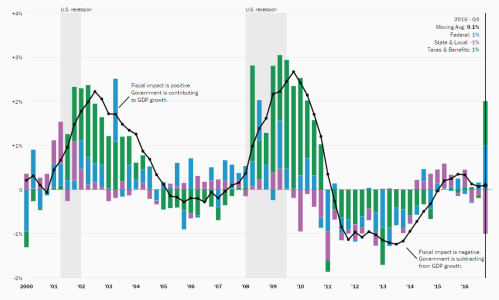This piece was originally published in January 2021. It has since been updated to reflect ongoing developments.
The Child Tax Credit, which has been expanded significantly by Congress since it was first written into law nearly 25 years ago, is a significant element of the federal government’s effort to aid families with children. Congress expanded it substantially when it passed President Biden’s American Rescue Plan in March 2021.
How did Congress expand the Child Tax Credit?
For one year, the Child Tax Credit—which reduces income taxes families owe dollar-for-dollar—was expanded in the American Rescue Plan from $2,000 per child to $3,600 for children below the age of 6 and to $3,000 for children under age 18. (Seventeen-year-olds, ineligible under the old law, were eligible for just one year.) The credit was reduced by $50 for every $1,000 above $112,500 for single heads of households and $150,000 for couples. But the old thresholds applied to the first $2,000, so no one who was previously eligible for that would be harmed.
Under the 2021 law, the credit was fully refundable, meaning families who owed little or no federal tax got a check for the full amount. Beginning in July 2021, payments were made monthly (up to $300 for children under the age of 6 and up to $250 for children between 6 and 17) beginning in July 2021 to 39 million households; this covered 88% of children in the United States, according to the U.S. Treasury.
The Treasury estimated that the expansion of the Child Tax Credit would lift more than 5 million more children above the poverty line.
Families didn’t have to wait until they filed their tax returns to benefit from the credit. In July 2021, the Internal Revenue Service began making partial payments monthly—up to $300 per month for each child under age 6 and up to $250 a month for each child between the ages of 6 and 17. The November 2021 payments totaled about $15 billion and went to 36 million families.
The expansion of the Child Tax Credit expired at the end of 2021.
How did the Child Tax Credit work before 2021?
Eligible families could claim a tax credit of up to $2,000 per child under age 17 who is a citizen of the U.S. The size of the credit was reduced by $50 for every $1,000 of adjusted gross income above $200,000 for single parents and $400,000 for married couples. Families who owed little or no income tax could get cash of up to $1,400 per child, a feature which made the tax credit only partially refundable.
Other dependents—including children aged 17 and 18, and full-time college students aged 19 to 24—were eligible for a non-refundable credit of up to $500.
More than 48 million households were projected to claim the Child Tax Credit for 2020, according to the congressional Joint Committee on Taxation. This will amount to $117.5 billion for qualifying families—twice the amount provided by the Earned Income Tax Credit, a program which supplements the wages of low-paid workers.
Although important to the low-income families who get it, and often promoted as a way to fight poverty, the Child Tax Credit is not targeted at those families, particularly after the changes made in 2017. About 40% of that $117.5 billion will go to households with incomes above $100,000. A relatively small share goes to low-income households—15% will go households with incomes under $30,000.

How has the Child Tax Credit evolved over the years?
The credit has its roots in a 1991 report by a bipartisan National Commission on Children, which declared that “it is a tragic irony that the most prosperous nation on earth is failing so many of its children” and recommended a $1,000 refundable credit for all children through age 18. A version of the credit was proposed by Republicans in their 1994 Contract with America and by President Clinton in 1995, and was eventually enacted in 1997 as a $500-per-child, non-refundable credit aimed at middle and upper middle income families.
After George W. Bush promised to double the credit as part of the tax cuts he proposed during his 2000 campaign, my Brookings colleague Isabel Sawhill argued for making it refundable so it would aid poor children. This would be, she wrote, controversial: “Many Republicans, in particular, are likely to label it as social welfare by another name. Democrats will point out that, without some refundability, income tax cuts do little to help many Americans.” But it was one way, she argued, to make sure that at least some of the benefits of the Bush tax cuts went to low-income families. When Congress enacted the Economic Growth and Tax Relief Reconciliation Act of 2001, it both doubled the Child Tax Credit to $1,000 per child and made it partly refundable.
The credit has been altered several times since—for more on the legislative history, see this Congressional Research Service report. It was expanded significantly in the 2017 Tax Cuts and Jobs Act, largely at the insistence of Sen. Marco Rubio (R-FL). That law increased the size of the credit for many (though not all) families, boosted the maximum portion of the credit that is refundable, and made many more upper-middle-income families eligible. (The credit is currently reduced gradually for single parents with incomes of more than $200,000 and couples with incomes of more than $400,000; under the prior law, the thresholds were $75,000 for single parents and $100,000 for couples.)

What are the politics of the Child Tax Credit?
Expanding the credit has been popular with both Democrats and Republicans in part because assisting low-income and middle-class families with children is regarded by members of Congress as both politically appealing and economically prudent.
In 2019, Senators Michael Bennet (D-CO) and Sherrod Brown (D-OH) and Representatives Rosa DeLauro (D-CT) and Suzan Delbene (D-WA) introduced legislation, the American Family Act, that would expand the Child Tax Credit from $2,000 to $3,000 per year for children between the ages of 6 and 16, and to $3,600 for younger children—and make it fully refundable. As written, their bill would have reduced benefits available to upper-income families, phasing out the credit beginning at $130,000 for single parents and $180,000 for couples (and eliminating it altogether for single parents with incomes above $150,000 and couples with incomes above $180,000). The American Family Act was popular among Democrats; about three-quarters of the Democrats in the last Congress were co-sponsors.
During the pandemic, the House included a one-year expansion of the credit in the 2020 HEROES Act; the Senate didn’t go along. That approach to COVID relief appealed to some conservative analysts, partly because it was more targeted than sending a check to nearly every household (as Congress eventually did). In the fall of 2020, a group of conservative scholars and leaders endorsed an additional, one-year, fully refundable Child Tax Credit of $2,000 in an open letter to Congress: “At a time when family budgets are under great stress and many parents have stopped working to care for their children, enlarging the child credit would offer much needed relief.”
In another indication of the credit’s bipartisan appeal, Senator Mitt Romney (R-UT) joined Senator Bennet in December 2019 in proposing a compromise that, among other things, would create a new Young Child Credit of $2,500 for children up to age 6, of which $1,500 would be refundable. It would also expand the refundability of the current credit for older children.
In his American Families Plan, President Biden proposed to make permanent the full refundability of the Child Tax Credit and to extend the increase in the size of the credit through 2025.
Will Congress extend the temporary expansion of the credit?
The expansion of the Child Tax Credit that was part of the American Rescue Plan expired at the end of December 2021. As part of the Build Back Better bill, the House voted in November 2021 to make permanent the refundability provisions that make the full credit available to children in families with low or no income. It also extended for one year—through 2022—the American Rescue Plan’s expansion of the credit. The Build Back Better bill did not pass the Senate.
In January 2024, Senate Finance Chair Ron Wyden and House Ways & Means Chair Jason Smith proposed a partial expansion of the Child Tax Credit as part of a broader tax bill. The House passed that bill 357-70 at the end of January. For more on that proposal, see this post from Tara Watson, director of the Brookings Center for Economic Security and Opportunity.
-
Acknowledgements and disclosures
The Brookings Institution is financed through the support of a diverse array of foundations, corporations, governments, individuals, as well as an endowment. A list of donors can be found in our annual reports published online here. The findings, interpretations, and conclusions in this report are solely those of its author(s) and are not influenced by any donation.






Commentary
What is the Child Tax Credit? And how much of it is refundable?
February 1, 2024